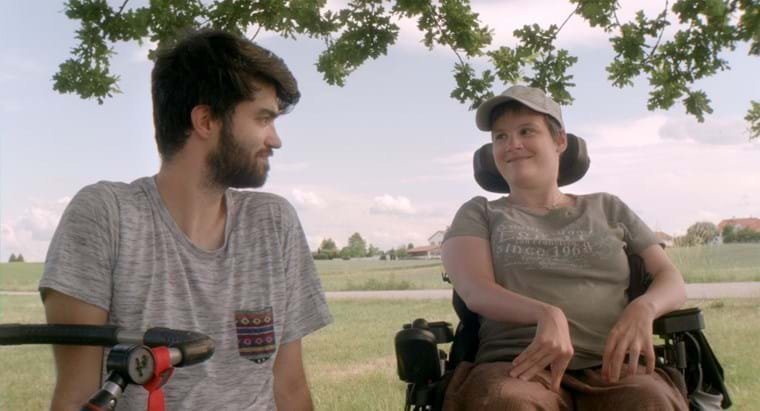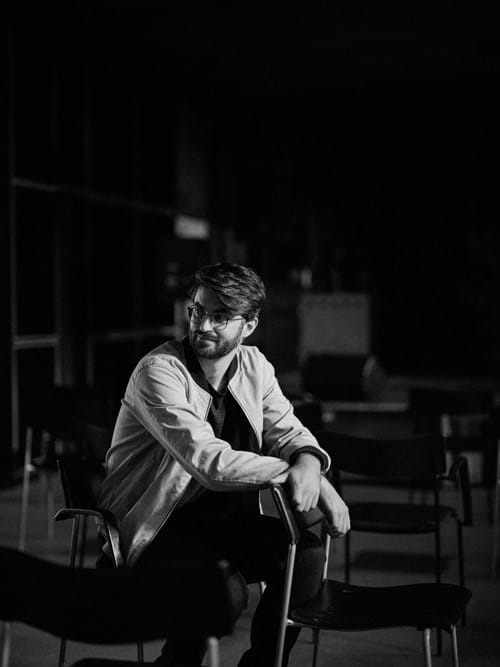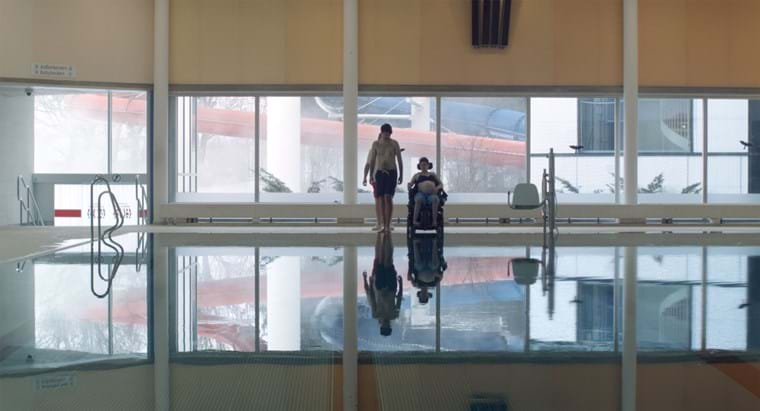An interview with director Lukas Ladner about his film Eva-Maria, the complexity of wanting a child, and the cinematic portrayal of those with disabilities
Lukas Ladner is not just a director. In fact, when this story starts, he is working as a personal assistant to Eva-Maria Proßegger. When she decides to have a baby, Ladner is inspired to shoot a cinematic portrait of her: Eva-Maria. The film is an in-depth study of all the phases the young woman went through, from her initial impulse to have a baby to the experience of parenthood for someone with a physical disability. In this interview, Lukas Ladner gives us insights into his intimate and multifaceted relationship with Eva-Maria, a relationship that was crucial to the filmmaking process. He also talks to TAKE about the potential and limitations of documentary filmmaking: the search for an adequate film language, how to capture subtle forms of discrimination, and alternative approaches to the homogenous portrayal of people with disabilities in film.
How did you come to make a film about a woman with a physical disability and her desire to have a child?
My primary intention was not to make a film about that topic, but rather about how people with disabilities are represented on screen. Eva-Maria and I watched films about people with disabilities as a lead-in and had many discussions about the depictions. The striking thing was that the focus is always on the disability itself: not only is it greatly exploited visually but it is also made the central conflict. If you watch several of these films, you start asking yourself why the protagonists don’t simply fall in love or rob a bank – in other words, why disabled people aren’t allowed to do the same things we allow ourselves to do all the time in fictional works. So for a long time, I wanted to make a short fictional film in which I cast people with disabilities without focusing on the disability. But then Eva-Maria told us she wanted to get pregnant. She prepared us – her personal assistants – for the fact that she was going to take this step. This was the ideal opportunity for me to work on the themes we had discussed together.
When we talk about the traditional depiction of people with disabilities in film – or lack thereof –, there’s always the question of how to portray them cinematically.
One of the first questions I asked myself was how to show this formally. I made it a rule not to show the disability itself, but rather to always keep the entire person in mind: don’t show the wheelchair by itself, don’t show the technical aids alone. Rather, stay with the subject, and film at eye level if possible. Avoid looking down on Eva-Maria. The point is not to exhibit the things that are perceived as exotic from the outside. It was very helpful that I had already worked for Eva-Maria for nine months. So that was already part of my world and I was able to embrace that with a certain normalcy.

It’s crucial for the film that you were involved with the central character on many levels and in different relational constellations. How did you deal with the situation of being a personal assistant and filmmaker simultaneously?
On the macro level, the film is based on the fact that I’m ubiquitous. I wanted to take advantage of the opportunity to be there all the time, in my role as assistant: We felt we had the potential to observe as many steps as possible of Eva-Maria’s journey and to avoid having to retell it. But it also means that your whole life is aligned with this film. Oftentimes you’re on pins and needles, waiting for these little moments to arrive quickly. On a micro level, it’s like a form of multitasking, where you have to switch between different tasks within short intervals. I experimented a lot while shooting; I kept looking at the footage and tried to learn from it.
Do you have the feeling that your affinity with Eva-Maria and the closeness you created ultimately benefited the film?
Most definitely. This was one reason why I shot on my own in the beginning: It’s a very intimate theme and I wanted to create as much closeness as possible. So that together we could find out what was comfortable for us, what was too much for us, and what it meant to keep our distance with the camera without losing anything. That’s a very emotional thing. And I found it rather difficult to portray this intimacy on film.
The film follows all the chronological stages of Eva-Maria’s journey, from her initial desire to have a child until the time when her son is one and a half years old. The theme of whether one should bring a child into the world is very present: It’s borne out of an intense idealism that, in retrospect, may no longer exist in the same way. Was the idea behind it that Eva-Maria could act as a role model?
The intention was to provide a positive counter model, of course. But it wasn’t about raising her to the level of a role model. We were mostly focused on bringing together all the narrative strands: the themes of motherhood, family, childhood. And to give a clear idea that you can take a stand as you wish: you can be for it, but you can also be against it. It was important to me to depict Eva-Maria’s thought processes and to show why motherhood is so important to her. Many people in my generation question whether they want children or can afford to have children at all. But for Eva-Maria, the decision was crystal clear: she wanted a child, that was her goal. That makes her the antithesis of our generation – and I found that exciting.
When you started filming, the desire to have a child was already very concrete. How did you decide that the film wouldn’t end with the birth of the son, but rather that the phase of life as the mother of a small child would be included in the film?
It felt important to us to include this aspect of the narrative: The question is, what does it mean to raise a child, as a woman with a disability? No one can imagine it accurately, because everything is hypothetical beforehand, and people have their own prejudices and expectations. Seeing how confidently Eva-Maria manages motherhood on her own was extremely good for the film. It made for a good ending.
The titular name Eva-Maria evokes Catholic associations for the film – and in addition to the empowerment of a wise person with unwavering optimism, the film also contains subtle overtones that echo onerous social conventions and discriminatory mechanisms that have existed for generations.
While the film was intended to show empowerment, it was not intended as a propaganda piece. It was meant to depict the complexity of life. Eva-Maria’s optimism is truly impressive – as is watching discrimination roll off her back. We incorporated some subtle elements of discrimination in the film but then removed them again because no viewer could really perceive them as discrimination. These things often seem like non-issues from the outside. I knew that Eva-Maria didn’t grow up in a sheltered bubble; she struggled with discrimination and structural problems. But that wasn’t so easy to capture.
In that quest, did you find yourself seeking something sensationalistic?
That’s always the hard part of documentary filmmaking. One hopes every day that the world will end, and that one can film it. But, of course, that’s a very fundamental ethical question: How far do I delve into these moments, to what extent do I probe, just how much do I want to put my protagonists through? These questions have to be resolved on an individual basis, from project to project, from person to person. In this case, I probed gently now and again, but if I had the feeling that there was a boundary, that Eva-Maria didn’t want to talk about it, it was absolutely fine with me.

The film is imbued with idyllic, richly traditional scenery from Tyrol. These mountain landscapes can appear confining to many – but in Eva-Maria’s life, they signify freedom. Did you have the intention of coding this landscape differently?
There are actually two reasons for that: First, it was my intention that the images I created should always have something to do with Eva-Maria. That’s why you never see the beautiful Old Town of Innsbruck – because Eva-Maria is never in the Old Town. I have always tried to follow her footsteps. But it’s true, I didn’t know for a long time how to deal with the mountains as a filmmaker myself, especially growing up in Tyrol. Aesthetically, these mountains are completely domesticated and remolded for touristic purposes, therefore I’ve always rejected them. It wasn’t until I came back to Innsbruck after university that I tried to deal with them in a new way and to give them a different charge.
Have any ideas for future projects emerged from your interaction with Eva-Maria?
What has long fascinated me about working as a personal assistant is this physical intimacy that one inevitably shares as part of certain professions, something which is perceived quite differently from the outside than it is from the inside. There’s friction between physical closeness and emotional distance, as one balances the self with one’s own clients and patients; this friction is not absolute but can always change into the opposite. That’s the subject of my next documentary. It will be a portrait about working with this intimacy, where I explore the question of its nature.

LUKAS LADNER was born in Innsbruck in 1991 and studied directing for film and television at the KONRAD WOLF Babelsberg Film University. He graduated in 2017 from the program with his short film Treibgut. His first feature-length documentary, Eva-Maria, had its world premiere at the DOK.Fest in Munich and was awarded the Diagonale Prize for Best Emerging Film in 2021. Lukas Ladner is currently working on his next documentary project, a worker’s portrait on intimacy, as a start-up scholarship holder of the Austrian Federal Ministry of Arts and Culture (BMKÖS).